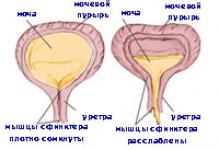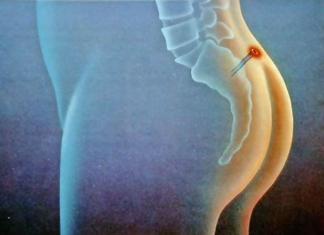ACE inhibitor
pharmachologic effect
ACE inhibitor. It is a prodrug from which the active metabolite ramiprilat is formed in the body. It is believed that the mechanism of antihypertensive action is associated with competitive inhibition of ACE activity, which leads to a decrease in the rate of conversion of angiotensin I to angiotensin II, which is a powerful vasoconstrictor. As a result of a decrease in the concentration of angiotensin II, a secondary increase in plasma renin activity occurs due to the elimination of negative feedback during the release of renin and a direct decrease in aldosterone secretion. Thanks to its vasodilating effect, it reduces roundabout percentage (afterload), wedge pressure in the pulmonary capillaries (preload) and resistance in the pulmonary vessels; increases cardiac output and exercise tolerance.
In patients with signs of chronic heart failure after myocardial infarction, ramipril reduces the risk of sudden death, progression of heart failure to severe/resistant heart failure, and reduces the number of hospitalizations for heart failure.
Ramipril is known to significantly reduce the incidence of myocardial infarction, stroke and cardiovascular death in patients with increased cardiovascular risk due to vascular diseases(CHD, previous stroke or peripheral vascular disease) or diabetes mellitus, which has at least one additional risk factor (microalbuminuria, arterial hypertension, increased total cholesterol, low level HDL, smoking). Reduces overall mortality and the need for revascularization procedures, slows the onset and progression of chronic heart failure. In both patients with and without diabetes mellitus, ramipril significantly reduces existing microalbuminuria and the risk of developing nephropathy. These effects are observed in patients with both high and normal blood pressure.
The hypotensive effect of ramipril develops after approximately 1-2 hours, reaches a maximum within 3-6 hours, and lasts for at least 24 hours.
Pharmacokinetics
When taken orally, absorption is 50-60%; food does not affect the degree of absorption, but slows down absorption. Cmax is reached after 2-4 hours. It is metabolized in the liver to form the active metabolite ramiprilat (6 times more active in inhibiting ACE than ramipril), inactive diketopiperazine and glucuronidated. All metabolites formed, with the exception of ramiprilat, have no pharmacological activity. Plasma protein binding for ramipril is 73%, ramiprilat is 56%. Bioavailability after oral administration of 2.5-5 mg of ramipril is 15-28%; for ramiprilat - 45%. After daily administration of ramipril at a dose of 5 mg/day, a steady-state concentration of ramiprilat in plasma is achieved by day 4.
T1/2 for ramipril - 5.1 hours; in the distribution and elimination phase, a drop in the concentration of ramiprilat in the blood serum occurs with T 1/2 - 3 hours, followed by a transition phase with T 1/2 - 15 hours, and a long final phase with very low concentrations of ramiprilat in plasma and T 1/2 - 4-5 days. T1/2 increases in chronic renal failure. V d ramipril - 90 l, ramiprilat - 500 l. 60% is excreted by the kidneys, 40% is excreted through the intestines (mainly in the form of metabolites). If renal function is impaired, the excretion of ramipril and its metabolites slows down in proportion to the decrease in CC; if liver function is impaired, the conversion to ramiprilat slows down; in heart failure, the concentration of ramiprilat increases by 1.5-1.8 times.
Arterial hypertension; chronic heart failure; heart failure that developed in the first few days after acute myocardial infarction; diabetic and non-diabetic nephropathy; reducing the risk of myocardial infarction, stroke and cardiovascular mortality in patients with high cardiovascular risk, including patients with confirmed coronary artery disease (with or without a history of infarction), patients who have undergone percutaneous transluminal coronary angioplasty, coronary artery bypass grafting, with a history of stroke, and patients with occlusive lesions of the peripheral arteries.
Severe renal and liver dysfunction, bilateral renal artery stenosis or stenosis of the artery of a single kidney; condition after kidney transplantation; primary hyperaldosteronism, hyperkalemia, aortic stenosis, pregnancy, lactation ( breast-feeding), children's and adolescence under 18 years of age, hypersensitivity to ramipril and other ACE inhibitors.
From the outside of cardio-vascular system: arterial hypotension; rarely - chest pain, tachycardia.
From the side of the central nervous system: dizziness, weakness, headache; rarely - sleep disturbances, mood disorders.
From the digestive system: diarrhea, constipation, loss of appetite; rarely - stomatitis, abdominal pain, pancreatitis, cholestatic jaundice.
From the respiratory system: dry cough, bronchitis, sinusitis.
From the urinary system: rarely - proteinuria, increased concentrations of creatinine and urea in the blood (mainly in patients with impaired renal function).
From the hematopoietic system: rarely - neutropenia, agranulocytosis, thrombocytopenia, anemia.
From the laboratory parameters: hypokalemia, hyponatremia.
Allergic reactions: skin rash, angioedema and other hypersensitivity reactions.
Others: rarely - muscle spasms, impotence, alopecia.
special instructions
In patients with concomitant renal impairment, doses are selected individually in accordance with CC values. Before starting treatment, all patients must undergo a kidney function test. During treatment with ramipril, renal function, blood electrolyte composition, levels of liver enzymes in the blood, as well as peripheral blood patterns are regularly monitored (especially in patients with diffuse connective tissue diseases, in patients receiving immunosuppressants, allopurinol). Patients who have fluid and/or sodium deficiency must have their fluid and electrolyte imbalances corrected before starting treatment. During treatment with ramipril, hemodialysis should not be performed using polyacrylonitrile membranes (the risk of anaphylactic reactions is increased).
For renal failure
Contraindicated in cases of severe renal dysfunction or conditions after kidney transplantation. In patients with concomitant renal impairment, doses are selected individually in accordance with CC values. Before starting treatment, all patients must undergo a kidney function test.
In case of liver dysfunction
Contraindicated in cases of severe liver dysfunction.
Use during pregnancy and breastfeeding
Ramipril is contraindicated for use during pregnancy and lactation (breastfeeding).
Drug interactions
With the simultaneous use of potassium-sparing diuretics (including spironolactone, triamterene, amiloride), potassium supplements, salt substitutes and dietary supplements containing potassium, hyperkalemia may develop (especially in patients with impaired renal function), because ACE inhibitors reduce the content of aldosterone, which leads to potassium retention in the body while limiting the excretion of potassium or its additional intake into the body.
When used simultaneously with NSAIDs, the hypotensive effect of ramipril may be reduced and renal function may be impaired.
When used simultaneously with loop or thiazide diuretics, the antihypertensive effect is enhanced. Severe arterial hypotension, especially after taking the first dose of a diuretic, appears to occur due to hypovolemia, which leads to a transient increase in the hypotensive effect of ramipril. There is a risk of developing hypokalemia. The risk of kidney dysfunction increases.
When used simultaneously with drugs that have a hypotensive effect, the hypotensive effect may be enhanced.
When used simultaneously with insulin, hypoglycemic agents, sulfonylurea derivatives, and metformin, hypoglycemia may develop.
When used simultaneously with allopurinol, cystostatics, immunosuppressants, procainamide, the risk of developing leukopenia may increase.
When used simultaneously with lithium carbonate, it is possible to increase the concentration of lithium in the blood serum.
Taken orally. The initial dose is 1.25-2.5 mg 1-2 times/day. If necessary, a gradual increase in dose is possible. The maintenance dose is set individually, depending on the indications for use and the effectiveness of treatment.
One of them is Ramipril.
This drug not only restores blood pressure, but also helps prevent many side effects caused by this disease.
Release form: white tablets with a mass fraction of the active substance of 2.5 mg, 5 mg and 10 mg.
Pharmacology
Slows down the change in the conversion of angiotensin 1 to angiotensin 2 and its absorption in the body.Reduces the release of norepinephrine from neuronal receptors and dulls nervous reactions caused by an increase in neurohumoral offensiveness.
Reduces the release of aldosterone and changes in bradykinin. Dilates renal vessels, causes reversal of hypertrophy of the left cardiac ventricle and abnormal transformations in the cardiovascular system.
Increases tissue sensitivity to insulin. The effect of taking the medicine begins after 1-2 hours, reaches its peak after 6 hours, and lasts for more than a day. Over the course of 3-4 weeks, the pressure gradually decreases and stabilizes with constant use. A one-time use of the drug reduces ACE activity by 60-80% within 4 hours and by 40-60% during the day.
Eating does not affect the absorption of the medicine, but it does reduce its rate.
Reduces mortality in the initial period of development and the number of repeated attacks. With six-month treatment with the drug, the level in patients with heart defects decreases. Reduces portal vein pressure in patients with portal hypertension.
Application
Ramipril is prescribed for patients with the following diseases:
- arterial hypertension;
- chronic heart failure;
- diabetic nephropathy;
- reducing the likelihood of myocardial infarction;
- reduction of coronary mortality in ischemic heart disease.
It can be used for coronary artery bypass surgery if the patient's condition is stable.
Directions for use and doses
Take orally regardless of food intake. The starting dose is 1.25-2.5 mg once or twice a day. The drug should always be taken at the same time to avoid oversaturation of the body active substance and, as a consequence, the appearance of unwanted adverse reactions. Maintenance dosage is prescribed individually.
Contraindications
Hypersensitivity to the active substance or similar, angioedema in the diagnosis, especially 1st trimester, breastfeeding.
Restrictions on use:

- autoimmune conditions;
- renal artery stenosis;
- kidney transplantation;
- leukopenia;
- liver dysfunction;
- dehydration of the body;
- atherosclerosis of the extremities;
In these conditions, constant monitoring of the patient’s condition, measuring the level of electrolyte balance in the body, taking a blood test, etc. is necessary.
Side effects
The following side effects may occur when taking Ramipril:

- from the cardiovascular system: heart failure, heart attack, blood anemia, chest pain;
- from the nervous system: drowsiness, insomnia, depression, tremor, visual and auditory disturbances;
- from the outside gastrointestinal tract : vomiting, diarrhea, diarrhea, dry mouth, liver dysfunction, pancreatitis;
- from the genitourinary system: edema, renal dysfunction;
- from the respiratory system: respiratory tract infections, bronchitis, laryngitis;
- from the skin: rash, urticaria, erythema;
- from other functions: anorexia, fever, anaphylactic reaction, edema of various origins.
Interaction with other drugs
 The medicine increases the effect on nervous system, during treatment with Ramipril you should avoid drinking alcoholic beverages.
The medicine increases the effect on nervous system, during treatment with Ramipril you should avoid drinking alcoholic beverages.
The effectiveness of the drug decreases with the simultaneous use of analgesics, and even table salt weakens the effect, so its use during treatment must be reduced to a minimum.
The development of hyperkalemia can cause simultaneous administration Amiloride, Spironolactone. Estrogens retain fluid in tissues, so the effect of taking Ramipril is reduced.
For what types of arterial hypertension is the use of Ranipril indicated?
Essential (primary) hypertension is a type of disease in which there are no signs of damage to other organs.
depend on indications blood pressure and are divided into three degrees:
- – blood pressure level 140/90-159/99 mmHg;
- – 160/100-179/109 mmHg;
- – above 180/100 mmHg.
Non-essential is an increase in blood pressure as a manifestation of another disease.
Renovascular hypertension is one of the types of symptomatic hypertension, in which an increase in blood pressure is provoked by renal vascular disease. With these types hypertension Ramipril showed good results. In most patients, blood pressure is restored and with long-term treatment is no longer a concern.
Any drug treatment should be carried out only after the drug has been prescribed by a doctor and only after a complete examination!
Ramipril helps lower blood pressure
 The main symptom of hypertension is headache, if it bothers the patient constantly, but at the same time he behaves healthy image life, then you should sound the alarm!
The main symptom of hypertension is headache, if it bothers the patient constantly, but at the same time he behaves healthy image life, then you should sound the alarm!
Perhaps this is a signal of problems with blood pressure. You should immediately go to the doctor for a diagnosis and further treatment.
Currently, no objective reasons have been found for this disease, but subjective reasons may include a person’s unhealthy lifestyle, smoking, alcohol abuse, sedentary lifestyle, geomagnetic storms, depression, problems in life, poor nutrition, poor nutrition and minerals.
If the diagnosis is made and treatment with Ramipril is prescribed, then the patient’s blood pressure is under control. Thanks to medicinal properties Ramipril blood pressure decreases on the first day of taking the drug, and throughout the entire treatment, changes cannot occur due to the strengthening and expanding effect of the active substance on the cardiovascular system.

Ramipril tablets
Moreover, during the action of this medicine, auxiliary substances are synthesized in the body, which fight blood pressure with greater force than Ramipril itself. Thanks to this action, the antihypertensive effect is doubled.
Unlike other drugs, Ramipril has a longer effect. It begins an hour after administration and continues for 24 hours after. Moreover, the substance can prevent the development of myocardial infarction, and if trouble occurs, it protects the body from the development of necrosis of tissues and cells.
During pregnancy, the use of this drug is contraindicated due to possible pathological changes in fetal tissue. Before use, you must make sure that there is no such drug, and if pregnancy occurs at the time of treatment with the medication, you must immediately replace this drug with another one.
Manufacturer and analogues
Ramipril is produced in a number of countries, drug manufacturers, including such companies as Actavis (Malta), Viva Pharm (Kazakhstan), Hoechst GmbH (Germany), Northern Star (Russia).
This popularity of the drug among manufacturers can be associated with high efficiency and high demand among the world's population. And a large number of both the medications themselves and their generics contributes to the development of competition in the market and maintaining low costs.
Preparations with the same active ingredient are produced in many countries and are known by names such as:

- Amprilan (KRKA, Slovenia);
- Corpryl;
- Pyramil (Sandoz, Switzerland);
- Ramigamma;
- Ramitren;
- Tritace (Sanofi-Avensis, France);
- (Egis, Hungary);
- Vasolong;
- Ramicardia;
- Ramepress;
- Ramipril-SZ (North Star, Russia);
- Dilaprel (Vertex, Russia).
When choosing a drug, full supervision of a specialist is required; Ramipril has a number of contraindications, side effects and limitations.
All of these drugs have the same effect on the patient’s body. These medications are produced in tablet form or capsules, and depending on the manufacturer, the number of tablets in the package differs slightly.
When purchasing a substitute, you should also pay attention to the composition of additional substances, since it is different and can cause harm to the body when allergic reaction for one or another component.
Video on the topic
Which ? You will find the answers in the video:
In conclusion, we would like to add that if you have never had problems with blood pressure, but are now worried about headaches, drowsiness and general malaise, then you need to sound the alarm and go to the doctor. Arterial hypertension rarely causes serious illness, and a large number of patients with heart attacks and strokes were previously unaware of the problems.
A doctor will make an accurate diagnosis, and you should always have a blood pressure monitoring device at hand at home. Then this disease will not cause big problems. To prevent blood pressure levels from going off scale, doctors advise: active recreation in nature, eating without excess salt and fat, giving up alcohol and smoking.
Dosage form: tablets Composition:Composition for 2.5 mg dosage
1 tablet contains:
ramipril in terms of 100% substance - 2.5 mg;Excipients:
microcrystalline cellulose - 27 mg; lactose (80 tablets) - 58.5 mg; colloidal silicon dioxide (Aerosil) - 0.2 mg; sodium carboxymethyl starch (Primogel) - 0.9 mg; magnesium stearate - 0.9 mg.Composition for 5 mg dosage
1 tablet contains:
Active substance:
ramipril in terms of 100% substance - 5 mg;Excipients:
microcrystalline cellulose - 40 mg; lactose (80 tablets) - 82.1 mg; colloidal silicon dioxide (Aerosil) - 0.3 mg; sodium carboxymethyl starch (Primogel) - 1.3 mg; magnesium stearate - 1.3 mg.Composition for 10 mg dosage
1 tablet contains:
Active substance:
ramipril in terms of 100% substance - 10 mg;Excipients:
microcrystalline cellulose - 50 mg; lactose (80 tablets) - 116.2 mg; colloidal silicon dioxide (Aerosil) - 0.4 mg; sodium carboxymethyl starch (Primogel) -1.7 mg; magnesium stearate - 1.7 mg. Description:Round flat-cylindrical tablets of white or almost white color with a chamfer and a score.
Pharmacotherapeutic group:Angiotensin-converting enzyme inhibitor (AIF) ATX:C.09.A.A ACE inhibitors
C.09.A.A.05 Ramipril
Pharmacodynamics:Ramipril is a long-acting angiotensin-converting enzyme (ACE) inhibitor.
ACE in blood plasma and tissues catalyzes the conversion of angiotensin I to angiotensin II and the breakdown of bradykinin. Therefore, when ramipril is taken orally, the formation of angiotensin II decreases and bradykinin accumulates, which leads to vasodilation and a decrease in blood pressure.
An increase in the activity of the kallikrein-kinin system in the blood and tissues determines the cardioprotective and endothelial-protective effects of ramipril due to the activation of the prostaglandin system and, accordingly, an increase in the synthesis of prostaglandins that stimulate the formation of nitric oxide
(N0)in endothelial cells. Angiotensin II stimulates the production of aldosterone, so taking ramipril leads to a decrease in aldosterone secretion and an increase in serum concentrations of potassium ions. By reducing the concentration of angiotensin II in the blood, its inhibitory effect on renin secretion by negative feedback is eliminated, which leads to an increase in plasma renin activity. It is assumed that the development of some adverse reactions(in particular dry cough) is also associated with increased bradykinin activity. In patients with arterial hypertension, taking ramipril leads to a decrease in blood pressure in the “lying” and “standing” positions, without a compensatory increase in heart rate (HR). significantly reduces total peripheral vascular resistance (TPVR), causing virtually no changes in renal blood flow and glomerular filtration rate.The hypotensive effect begins to appear 1-2 hours after ingestion of a single dose of the drug, reaching its greatest value after 3-9 hours, and persists for 24 hours. During a course of treatment, the hypotensive effect can gradually increase, usually stabilizing by 3-4 weeks of regular use of the drug and then persisting for a long time. Sudden cessation of taking the drug does not lead to the development of withdrawal syndrome.
In patients with arterial hypertension, it slows down the development and progression of myocardial and vascular wall hypertrophy. The drug reduces mortality in the early and late periods of myocardial infarction, the incidence of recurrent infarctions and the incidence of heart failure. Increases survival rate and improves quality of life in patients with chronic heart failure.
Reduces the degree of microalbuminuria (in initial stage) and progression of chronic renal failure in patients with severe kidney damage due to diabetic nephropathy.
Pharmacokinetics:Precautions:
At the beginning of treatment, renal function should be assessed. It is necessary to carefully monitor renal function during treatment with the drug, especially in patients with weakened renal function, with damage to the renal vessels (for example, clinically insignificant renal artery stenosis); heart failure.
After taking the first dose, as well as when increasing the dose of the diuretic and/or Ramipril, patients should be under medical supervision for 8 hours to avoid the development of an uncontrolled hypotensive reaction.
In patients with chronic heart failure, taking the drug can lead to the development of severe arterial hypotension, which in some cases is accompanied by oliguria or azotemia and rarely by the development of acute renal failure. Patients with malignant arterial hypertension should begin treatment in a hospital setting.
Before and during treatment with the drug, it is necessary to monitor blood pressure, kidney function (creatinine), potassium and other electrolytes, hemoglobin, and the activity of “liver” transaminases.
The risk of hypersensitivity and allergy-like (anaphylactoid) reactions increases in patients concomitantly taking ACE inhibitors and undergoing hemodialysis procedures using dialysis membranes
AN69.Similar reactions have been observed with low-density lipoprotein apheresis using dextrin sulfate, so this method should be avoided during treatment with ACE inhibitors.During treatment with the drug in patients with impaired renal function, especially with simultaneous treatment with diuretics, the concentration of urea and creatinine in the blood serum may increase. In this case, treatment should be continued with smaller doses of the drug or the drug should be discontinued. In patients with impaired renal function, the risk of hyperkalemia increases.
In patients with impaired liver function, due to a decrease in the activity of hepatic transaminases, the metabolism of ramipril and the formation of an active metabolite may be slowed down. In this regard, treatment of such patients should only be started under strict medical supervision.
In rare cases, during the use of ACE inhibitors, cholestatic jaundice occurs, with the progression of which fulminant liver necrosis develops, sometimes with a fatal outcome. If jaundice appears or a significant increase in the activity of “liver” transaminases, treatment with the drug should be discontinued. Caution must be exercised when prescribing the drug to patients on a low-salt or salt-free diet (increased risk of developing arterial hypotension). In patients with a reduced circulating blood volume (as a result of diuretic therapy), symptomatic arterial hypotension may develop during dialysis, diarrhea and vomiting.
Transient arterial hypotension is not a contraindication for continuing treatment after stabilization of blood pressure. If severe hypotension reoccurs, the dose should be reduced or the drug discontinued.
Before surgery, including dentistry, it is necessary to warn the surgeon and anesthesiologist about the use of ACE inhibitors, because the use of ACE inhibitors in patients undergoing surgery using general anesthesia, can lead to a pronounced decrease in blood pressure, especially when using general anesthesia agents that have a hypotensive effect. It is recommended to stop taking ACE inhibitors, including Ramipril, 12 hours before surgery.
In rare cases, agranulocytosis, erythrocytopenia, thrombocytopenia, hemoglobinemia or bone marrow suppression have been observed during treatment with ACE inhibitors. At the beginning and during treatment, it is necessary to monitor the number of blood leukocytes to detect possible neutropenia/agranulocytosis. More frequent monitoring is recommended in patients with renal failure, with connective tissue diseases (for example, systemic lupus erythematosus or scleroderma) and in patients simultaneously taking drugs that affect hematopoiesis (see section "Interactions with other drugs").
The counting of blood cells should also be carried out when clinical signs neutropenia/agranulocytosis and increased bleeding.
In patients with arterial hypertension, when treated with the drug, an increase in potassium levels in the blood serum is rarely observed. The risk of hyperkalemia increases with chronic heart failure, simultaneous treatment with potassium-sparing diuretics (, amiloride, triamterene) and the prescription of potassium supplements.
Cases of angioedema of the face, extremities, lips, tongue, pharynx or larynx have been observed in patients treated with ACE inhibitors. If swelling occurs in the face (lips, eyelids) or tongue, or difficulty swallowing or breathing, the patient should immediately stop taking the drug. Angioedema localized in the tongue, pharynx, or larynx ( possible symptoms: impaired swallowing or breathing) can be life-threatening and requires urgent measures to relieve it: subcutaneous administration of 0.3-0.5 mg or intravenous drip of 0.1 mg of epinephrine (under the control of blood pressure, heart rate and ECG) followed by the use of glucocorticosteroids (i.v., i.m., or orally); also recommended intravenous administration antihistamines
(antagonists of H1- and H2-histamine receptors), and in case of insufficiency of enzyme C inactivators\ -esterase, the need to administer C1-esterase enzyme inhibitors in addition to epinephrine may be considered. The patient should be hospitalized and monitored until symptoms are completely relieved, but not less than 24 hours.Cases of intestinal angioedema, manifested by abdominal pain with or without nausea and vomiting, have been observed in patients receiving ACE inhibitors; in some cases, angioedema of the face was simultaneously observed. If a patient develops the above-described symptoms during treatment with ACE inhibitors, the patient should differential diagnosis consider the possibility of developing intestinal angioedema in them.
When using ACE inhibitors during desensitization therapy to wasp or bee venom, anaphylactic and anaphylactoid reactions (for example, arterial hypotension, shortness of breath, vomiting, skin rash) may occur, which can be life-threatening.
Hypersensitivity reactions may occur from insect bites (such as bees or wasps). If desensitizing treatment is necessary (for bites), it is necessary to discontinue ACE inhibitors and continue treatment with suitable antihypertensive drugs from other groups.
During therapy with an ACE inhibitor, a dry cough may occur, which disappears after discontinuation of drugs in this group. If a dry cough appears, you should remember the possible connection of this symptom with taking ACE inhibitor.
Simultaneous use the drug with aliskiren-containing drugs in patients with diabetes mellitus and renal failure (creatinine clearance less than 60 ml/min) is contraindicated (see sections “Interaction with other drugs”, “Contraindications”).
Concomitant use of the drug with angiotensin II receptor antagonists in patients with diabetic nephropathy is contraindicated (see sections "Interaction with other drugs", "Contraindications"),
Caution should be exercised during exercise and in hot weather due to the risk of dehydration and hypotension due to decreased fluid volume.
Impact on the ability to drive vehicles. Wed and fur.:During treatment with the drug, care must be taken when administering vehicles and occupation of others potentially dangerous species activities requiring increased concentration and speed of psychomotor reactions (dizziness is possible, especially after the initial dose of an ACE inhibitor in patients taking diuretic drugs, as well as other conditions that may affect the ability to drive vehicles).
Release form/dosage:Tablets 2.5 mg, 5 mg and 10 mg. 10 or 14 tablets per blister pack.
Package:10 or 14 tablets per blister pack.
3 blister packs of 10 tablets each or 1, 2 blister packs of 14 tablets each along with instructions for use in a cardboard pack.
Storage conditions:At a temperature not higher than 25 °C. Keep out of the reach of children.
Best before date:2 years. Do not use after the expiration date stated on the packaging.
InstructionsEssential hypertension. - Chronic heart failure (as part of combination therapy, in particular in combination with diuretics). - Diabetic or non-diabetic nephropathy, preclinical and clinically pronounced stages, including with severe proteinuria, especially when combined with arterial hypertension. - Reducing the risk of myocardial infarction, stroke or cardiovascular mortality in patients with high cardiovascular risk: in patients with confirmed coronary disease heart, with or without a history of myocardial infarction, including patients who underwent percutaneous transluminal coronary angioplasty, coronary artery bypass grafting; · in patients with a history of stroke; · in patients with occlusive lesions of peripheral arteries; · in patients with diabetes mellitus with at least one additional risk factor (microalbuminuria, arterial hypertension, increased plasma concentrations of TC, decreased plasma concentrations of HDL cholesterol, smoking). - Heart failure that developed during the first few days (from 2 to 9 days) after acute myocardial infarction
Contraindications Ramipril-SZ tablets 2.5 mg
Essential hypertension. - Chronic heart failure (as part of combination therapy, in particular in combination with diuretics). - Diabetic or non-diabetic nephropathy, preclinical and clinically pronounced stages, including with severe proteinuria, especially when combined with arterial hypertension. - Reducing the risk of myocardial infarction, stroke or cardiovascular mortality in patients with high cardiovascular risk: in patients with confirmed coronary artery disease, a history of myocardial infarction or without it, including patients who have undergone percutaneous transluminal coronary angioplasty, coronary artery bypass grafting ; · in patients with a history of stroke; · in patients with occlusive lesions of peripheral arteries; · in patients with diabetes mellitus with at least one additional risk factor (microalbuminuria, arterial hypertension, increased plasma concentrations of TC, decreased plasma concentrations of HDL cholesterol, smoking). - Heart failure that developed during the first few days (from 2 to 9 days) after acute myocardial infarction (see section “Pharmacodynamics”). CONTRAINDICATIONS - Hypersensitivity to ramipril, other ACE inhibitors, or to any of the components of the drug (see section "Composition"). - Angioedema (hereditary or idiopathic, as well as after taking ACE inhibitors) in history - the risk of rapid development of angioedema (see section "Side effects"). - Hemodynamically significant stenosis of the renal arteries (bilateral or unilateral in the case of a solitary kidney). - Arterial hypotension (systolic blood pressure less than 90 mm Hg) or conditions with unstable hemodynamic parameters. - Hemodynamically significant stenosis of the aortic or mitral valve or hypertrophic obstructive cardiomyopathy (HOCM). - Primary hyperaldosteronism. - Heavy renal failure(CC less than 20 ml/min with a body surface of 1.73 m2) (experiment clinical application insufficient). - Pregnancy. - Lactation period. - Nephropathy, which is treated with glucocorticosteroids, non-steroidal anti-inflammatory drugs, immunomodulators and/or other cytotoxic agents (experience of clinical use is insufficient, see section “Interaction with other drugs”). - Chronic heart failure in the stage of decompensation (experience of clinical use is insufficient). - Age up to 18 years (experience of clinical use is insufficient). - Hemodialysis (experience of clinical use is insufficient). Hemodialysis or hemofiltration using certain membranes with a negatively charged surface, such as high-flux polyacrylonitrile membranes (risk of hypersensitivity reactions) (see sections "Interactions with other drugs", " special instructions"). - Apheresis of low-density lipoproteins using dextran sulfate (risk of hypersensitivity reactions) (see section Special instructions). - Desensitizing therapy for hypersensitivity reactions to the poisons of insects, such as bees, wasps (see section “Special instructions”). Additional contraindications when using Ramipril in acute stage myocardial infarction: - severe heart failure (functional class IV according to the NYHA classification); - unstable angina; - life-threatening ventricular arrhythmias; - “pulmonary” heart. With caution - Conditions in which an excessive decrease in blood pressure is especially dangerous (with atherosclerotic lesions of the coronary and cerebral arteries). - Conditions accompanied by increased activity of the renin-angiotensin-aldosterone system (RAAS), in which there is a risk when inhibiting AIIF sharp decline Blood pressure with deterioration of renal function: severe arterial hypertension, especially malignant arterial hypertension; chronic heart failure, especially severe or for which other drugs with antihypertensive effects are being taken; hemodynamically significant unilateral renal artery stenosis (in the presence of both kidneys); previous use of diuretics; disturbances in water and electrolyte balance as a result of insufficient intake of liquid and table salt, diarrhea, vomiting, profuse sweating. - Liver dysfunction (lack of experience with use: it is possible to either enhance or weaken the effects of ramipril; in patients with cirrhosis of the liver with ascites and edema, significant activation of the RAAS is possible, see above Conditions accompanied by increased activity of the RAAS). - Impaired renal function (creatinine clearance more than 20 ml/min. with a body surface of 1.73 m2) due to the risk of developing hyperkalemia and leukopenia). - Condition after kidney transplantation. - Systemic diseases connective tissue, including systemic lupus erythematosus, scleroderma, concomitant therapy with drugs that can cause changes in the peripheral blood picture (possible inhibition of bone marrow hematopoiesis, development of neutropenia or agranulocytosis, see section Interaction with other drugs). - Diabetes mellitus (risk of developing hyperkalemia). - Elderly age(risk of increased hypotensive effect). - Hyperkalemia. Use during pregnancy and breastfeeding Ramipril-SZ is contraindicated during pregnancy, as it may have adverse effects on the fetus: impaired development of the fetal kidneys, decreased blood pressure in the fetus and newborns, impaired renal function, hyperkalemia, hypoplasia of the skull bones, oligohydramnios, contracture of the limbs, deformation of the skull bones, pulmonary hypoplasia. Therefore, before starting to take the drug in women of childbearing age, pregnancy should be excluded. If a woman is planning a pregnancy, treatment with ACE inhibitors should be discontinued. If pregnancy is diagnosed during treatment with Ramipril-SZ, you should stop taking it as soon as possible and transfer the patient to take other drugs, the use of which will have the least risk for the child. If treatment with Ramipril-SZ is necessary during breastfeeding, then breastfeeding should be discontinued.
Method of administration and dosage Ramipril-SZ tablets 2.5 mg
The tablets must be swallowed whole (do not chew) and washed down with a sufficient amount (1/2 glass) of water, regardless of meals (that is, the tablets can be taken before, during or after meals). The dose is selected depending on therapeutic effect and patient tolerance of the drug. Treatment with Ramipril-SZ is usually long-term, and its duration in each case is determined by the doctor. Unless otherwise prescribed, the following dosage regimens are recommended in the presence of normal renal and hepatic function. For essential hypertension Usually the initial dose is 2.5 mg 1 time per day in the morning. If, when taking the drug at this dose for 3 weeks or more, it is not possible to normalize blood pressure, then the dose can be increased to 5 mg of ramipril per day. If the dose of 5 mg is insufficiently effective, after 2-3 weeks it can be further doubled to the maximum recommended daily dose of 10 mg per day. As an alternative to increasing the dose to 10 mg per day if the antihypertensive effectiveness of the daily dose of 5 mg is insufficient, it is possible to add other antihypertensive drugs to the treatment, in particular diuretics or blockers of “slow” calcium channels. For chronic heart failure: Recommended initial dose: 1.25 mg 1 time per day (1/2 tablet 2.5 mg). Depending on the patient's response to the therapy, the dose may be increased. It is recommended to double the dose at intervals of 1-2 weeks. If a daily dose of 2.5 mg or higher is required, it can be given either once a day or divided into 2 doses. Maximum recommended daily dose is 10 mg. For diabetic or non-diabetic nephropathy: Recommended starting dose: 1.25 mg 1 time per day (1/2 tablet 2.5 mg). The dose may be increased to 5 mg once daily. For these conditions, doses above 5 mg once daily in controlled settings clinical studies insufficiently studied. To reduce the risk of heart attack, stroke, or cardiovascular mortality in patients at high cardiovascular risk. Recommended starting dose: 2.5 mg once daily. Depending on the patient's tolerance to the drug, the dose can be gradually increased. It is recommended to double the dose after 1 week of treatment, and over the next 3 weeks of treatment, increase it to the usual maintenance dose of 10 mg once daily. Doses greater than 10 mg have not been sufficiently studied in controlled clinical studies. The use of the drug in patients with CC less than 0.6 ml/sec has not been sufficiently studied. For heart failure that develops during the first few days (from the 2nd to the 9th day) after acute myocardial infarction, the recommended initial dose is 5 mg per day, divided into two single doses of 2.5 mg, taken one in the morning, and the second - in the evening. If the patient does not tolerate this initial dose (an excessive decrease in blood pressure is observed), then it is recommended that he be given 1.25 mg 2 times a day (1/2 tablet 2.5 mg) for two days. Then, depending on the patient's response, the dose may be increased. It is recommended that the dose be doubled at intervals of 1-3 days when increasing it. Later, the total daily dose, which was initially divided into two doses, can be given once. The maximum recommended dose is 10 mg. Currently, the experience of treating patients with severe heart failure (III-IV functional class according to the NYHA classification) that occurs immediately after acute myocardial infarction is insufficient. If the decision is made to treat such patients with Ramipril-SZ, it is recommended that treatment begin with the lowest possible dose - 1.25 mg once daily (1/2 tablet 2.5 mg) and special care should be taken with each increase doses. Use of the drug Ramipril-SZ in separate groups patients - Patients with impaired renal function With CC from 50 to 20 ml/min per 1.73 m2 of body surface, the initial daily dose is usually 1.25 mg (1/2 tablet 2.5 mg). The maximum permissible daily dose is 5 mg. - Patients with incompletely corrected loss of fluid and electrolytes, patients with severe arterial hypertension, as well as patients for whom an excessive decrease in blood pressure poses a certain risk (for example, with severe atherosclerotic lesions of the coronary and cerebral arteries) The initial dose is reduced to 1.25 mg/day day (1/2 tablet 2.5 mg). - Patients with previous diuretic therapy It is necessary, if possible, to discontinue diuretics 2-3 days (depending on the duration of action of the diuretics) before starting treatment with Ramipril-SZ, or at least reduce the dose of diuretics taken. Treatment of such patients should begin with the lowest dose of ramipril 1.25 mg (1/2 2.5 mg tablet) taken once daily in the morning. After taking the first dose and whenever the dose of ramipril and/or loop diuretics is increased, patients should be under medical supervision for at least 8 hours to avoid an uncontrolled hypotensive reaction. - Elderly patients (over 65 years old) The initial dose is reduced to 1.25 mg per day (1/2 tablet 2.5 mg). - Patients with impaired liver function The blood pressure response to taking the drug Ramipril-SZ can either increase (due to slowing the excretion of ramiprilat) or decrease (due to slowing the conversion of low-active ramipril into active ramiprilat). Therefore, careful medical supervision is required at the beginning of treatment. The maximum permissible daily dose is 2.5 mg.
Ramipril is a synthetic antihypertensive drug. It exhibits a cardioprotective effect, reduces total vascular peripheral resistance, reduces the risk of mortality during myocardial infarction, as well as the incidence of recurrent infarctions.
The drug is used to treat heart failure, diabetic and non-diabetic nephropathy, arterial hypertension and as a prophylactic agent in the post-infarction period.
Ramipril is an ACE inhibitor. It is a prodrug from which the active metabolite ramiprilat is formed in the body. The “effectiveness” of ramipril in terms of lowering blood pressure knows no age, gender, or constitutional (body weight) boundaries: the drug can help everyone. However, as a rule, it does not cause excessive hypotension at the beginning of treatment, and abrupt discontinuation of the drug is not fraught with the development of withdrawal syndrome.
Ramipril, along with enalapril, is the most studied ACE inhibitor. It has shown itself not only in terms of lowering blood pressure, but also has a number of positive effects on the kidneys, heart, blood vessels (of course, only in those who have hypertension and/or diabetes and/or ischemic heart disease). Improved prognosis for chronic ischemic heart disease.
All this happened, of course, it happens:
1) with long-term use of Ramipril;
2) upon reception original drug, and not its generic copies.
Ramipril photo
The active ingredient of Ramipril is ramipril, in 1 tablet – 2.5 mg, 5 mg or 10 mg.
Clinical studies have proven that ramiprilat, the active metabolite of Ramipril, inhibits angiotensin-converting enzyme much more strongly. Because of this, Ramipril, analogues and complex drugs are the drugs of choice for difficult-to-control hypertension.
Indications for use Ramipril
The medication is indicated for use in the following diseases:
- with essential hypertension;
- as part of complex multiclass therapy of chronic heart failure;
- for diabetic and other nephropathy at the clinical or subclinical stage, not associated with renal artery stenosis;
- for symptomatic arterial hypertension;
- for the prevention of myocardial infarction, reducing mortality in patients with cardiac diseases, as well as for the treatment of hypertension with a high total cardiovascular risk.
Instructions for use Ramipril, dosage
Taken orally. The initial recommended dosage of Ramipril is 1.25-2.5 mg 1-2 times a day. If necessary, a gradual increase in dose is possible. The maintenance dosage is set individually, depending on the indications for use and the effectiveness of therapy.
The regimen for taking Ramipril for blood pressure will depend, first of all, on the diagnosis and treatment goals, and should be selected by a specialized medical specialist.
Features of application
After taking the first dose of the drug, as well as when increasing the dosage of the diuretic and/or ramipril, patients should be under medical supervision for 8 hours to avoid the development of an uncontrolled hypotensive reaction.
During the treatment period, care must be taken when driving vehicles and engaging in other potentially hazardous activities that require increased concentration and speed of psychomotor reactions (dizziness is possible, especially after the initial dose of an ACE inhibitor in patients taking diuretic drugs).
Side effects and contraindications Ramipril
Serious side effects Ramipril is very rare; If they occur, consult a doctor immediately.
Most often, the following adverse reactions from organs and systems occur to the drug:
Fever and chills, sore throat and hoarseness, sudden difficulty breathing or swallowing, swelling of the face, mouth or limbs, kidney problems (swelling in the ankles, decreased urination), confusion, yellow discoloration of the eyes or skin (a sign of liver problems) ), severe itching, chest pain, palpitations, abdominal pain.
Overdose
Symptoms of an overdose of Ramipril: acute arterial hypotension, cerebrovascular accident, angioedema, myocardial infarction, thromboembolic complications.
Treatment: dose reduction or complete withdrawal of the drug; gastric lavage, transferring the patient to a horizontal position, taking measures to increase blood volume.
Contraindications
Hypersensitivity, hypotension, severe renal failure, severe hyperkalemia, pregnancy, breastfeeding.
A complete list of contraindications and restrictions for the use of Ramipril should be studied in the instructions attached to the drug. Use strictly as prescribed by the doctor (therapist, neurologist, cardiologist, nephrologist).
Analogues of Ramipril, list
Pharmacological group of Ramipril - Angiotensin-converting enzyme (ACE) inhibitors. Names of drugs (list):
- Corpril,
- Ramitren,
- Tritace,
- Hartil,
- Amprilan,
- Pyramid,
- Ramigamma.
Other analogues medicine with similar effects and indications for use:
- Vinoxin-MV (VINCAMINUM) Oral tablets;
- No-Spa Oral tablets;
- Magnesium sulfate ( Magnesium sulfate) Substance-powder;
- Magnesium sulfate (Magnesium sulfate) Powder for the preparation of suspension for oral administration;
- Liprazidum 10 Oral tablets;
- Niacin (Niacyne) Substance-powder;
- Lisinopril Tablets;
- Parnavel Tablets;
- Diroton Tablets;
- Perindopril Oral tablets.
Important - instructions for use of Ramipril, price and reviews do not apply to analogues and cannot be used as a guide to the use of drugs of similar composition or action. All therapeutic prescriptions must be made by a doctor. When replacing Ramipril with an analogue, it is important to consult a specialist; you may need to change the course of therapy, dosage, etc. Do not self-medicate!


























